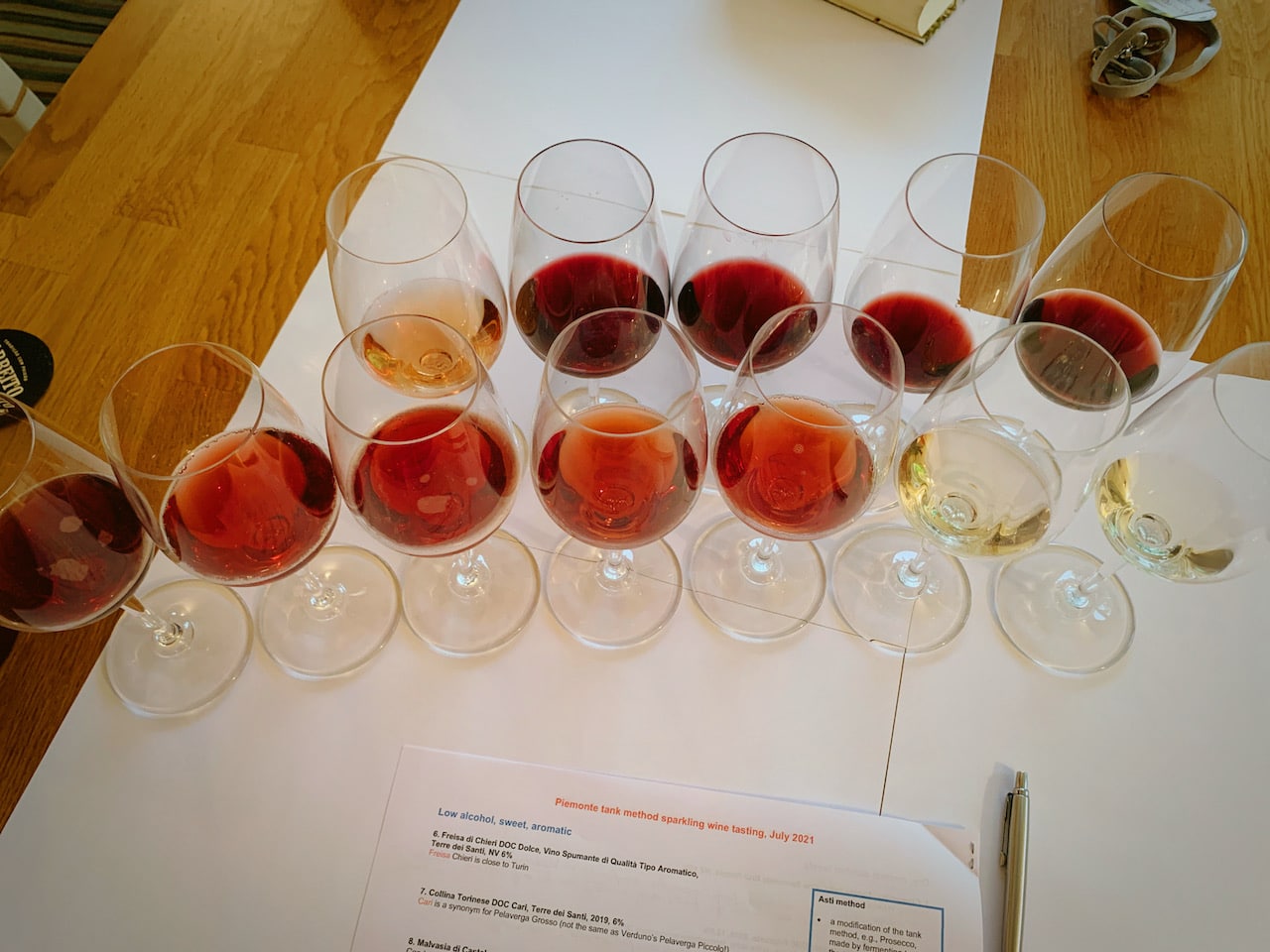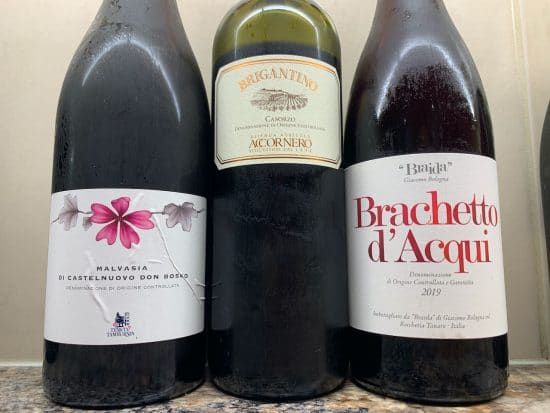Aiming for pure fruit expression
Tank method sparkling wine has such a bad rap. Do we complain that delicious, refreshing Beaujolais is not grand cru Burgundy? Both have their time and place. In the same way, it makes no sense to compare a fruity and undemanding Prosecco with a grand Champagne. Indeed, within Piemonte, there is no sense in comparing Alta Langa DOCG with Asti or Moscato d’Asti. The point is that the wines are made with completely different aims in mind and with different technologies. With traditional method sparkling wine, the aim is refinement and complexity, with muted fruit character and added complexity from long ageing on the lees. With tank method sparkling wines, the aim is purity of fruit expression and no lees ageing notes. The sheer strength of fruit expression can vary enormously from moderate intensity with Prosecco to exuberant with Moscato but the aim is the same. And surely, we are not going to mark tank method wines down because they are cheaper? And incidentally, to my taste, poor quality Cava or Champagne is a less desirable drink than good Prosecco or Asti. The bottles might cost the same but the latter are going to be better to drink.
Technical challenges
The history of the two technologies is in itself fascinating. Historically, second fermentation in the bottle is much older. Perhaps rather surprisingly, it was the Champenois who first conducted experiments with second fermentation in tanks around 1850. However, they could not find a solution to technical problems. They were seeking to tackle the challenges of bottle-fermented wines that, then, were the labour involved and the fragility of the glass available. There is no hint in the (admittedly sparse) record that they were seeking an alternative style of wine. The technical problems took time to solve. In 1895 Martinotti patented his ‘apparatus for continuous production’, In 1907 Eugène Charmat came up with a more practical solution. Finally, vitrified or enamelled iron tanks were replaced with stainless steel ones in the 1970s.

Once the technical challenges were conquered, the way was clear for a whole new style of wine to be made. Italy has gone on to dominate the world of tank method sparkling wine. Its wealth of semi- and fully-aromatic grape varieties and its skill at the production of technically advanced winemaking equipment has made it the natural leader. In short, if you want fruit-expressive sparkling wines at reasonable prices, you need to look no further than Italy and the Veneto and Piemonte in particular. If you are interested in the history of the wine and the technology, I will have the chance to cover it in more detail in my forthcoming book, The Wines of Piemonte in the Classic Wine Library.
A variety of varieties
Within Piemonte, the temptation is to look no further than wines made with the Moscato variety. But again, the range of tank method sparkling wine extends far beyond Asti (Spumante) and Moscato d’Asti. Following my recent post on traditional method sparkling wine, I assembled a range of tank method sparkling wines from Piemonte to taste the various wines side-by-side. With the help of some producers and one internet order from Italy, I could muster 12 wines. There were four dry sparklers from three varieties, one dry rosé from another red variety and seven low alcohol, sweet, wines (five reds, two whites) made for a further five varieties. No shortage of variety there!

Dry, normal alcohol levels
Clementina, Tenute Sella, Vino Spumante Brut Rosato, NV 13%
100% Nebbiolo from Lessona. This is orange-pink and pale in colour, a delightful, fresh and aromatic wine with complexity: floral, sour red cherry, a touch of something herbal. An excellent depth of fruit is balanced by racy acidity if with a softening sweetness on the finish in a dry wine. One sniff of this and I wondered if it was going to be the wine of the evening!
Goj, Barbera del Monferrato DOC Frizzante, 2019, 13.5%
100% Barbera, Costigliole d’Asti, 6–7 days on the skins, fermentation temperature 28º C., in stainless steel, natural refermentation before bottling. This involves making use of the natural sugar in a portion of the pressed juice that is preserved. It is then added to the wine just before bottling to give the sugar for second fermentation). Deep ruby with a youthful tint, ripe damson and blackberry fruit with a violet, floral lift, medium-bodied and light tannins. very lightly sparkling but enough to give it a lift. Another excellent wine at the beginning of the line up.
Moyé, Piemonte DOC Bonarda Frizzante, Cascina Gilli, 2020, 13%
100% Bonarda, Castelnuovo Don Bosco, fermented to dry, goes through MLF, natural refermentation in tank before bottling. Bramble fruit, something meaty and medicinal, lacks the immediate fruity appeal of the Barbera tasted immediately before but this is unusual and worth seeking out.



Barbera, Nebbiolo sparkler, all the dry sparklers
Luna di Maggio, Freisa d’Asti DOC Frizzante, Cascina Gilli, 2019, 13.5%
100% Freisa, natural refermentation in tank before bottling. Medium ruby, fresh with floral, strawberry and a slight umami note, intriguing. Medium-firm but ripe tannins (Freisa is a very tannic variety, see Freisa, Nebbiolo’s rustic relative.) I was expecting this to be tough but this has been very well handled.
Martirella, Vino Rosso, Claudio Mariotto, NV 12.5%
Blend of Freisa, Barbera, Bonarda, Tortona, bottled at a rising moon, apparently an ancient tradition to exalt vivacity and freshness. Having tried three wines made with single varieties, here is a blend of the three varieties. Garnet tint already showing and the wines already tastes a bit oxidised if with blackberry, damson and farmyard/leather (touch of Brett?) notes, moderate tannins. In a rustic style but drinkable. Is this trying to hard to be a trendy natural wine?
These–dry with normal levels of alcohol–are such fascinating wines and quite a long way out of most wine drinkers’ experience. As far as I can see, the only sources for these wines in the UK are web-based. Examples are the specialist importer Tannico or other companies that import directly from Italy. Braida’s La Monella (frizzante Barbera) is available in the US.) ?
Low alcohol, sweet, aromatic, frizzante wines
This category is much better known, principally through Asti and Moscato d’Asti. They are made by the modification of the standard tank method known as the Asti method. I will write about that on another occasion. The method makes low alcohol (5–7% abv) sweet wines and is mainly used with fully aromatic varieties. The most famous of these is, of course, Moscato, but Piemonte is home to a good handful of others.

Freisa di Chieri DOC Dolce, Vino Spumante di Qualità Tipo Aromatico, Terre dei Santi, NV 6%
We have met the variety Freisa already and Chieri is a historic area for wine production close to Turin. Pale ruby in colour with an orange tint, a medium intensity nose with strawberry and raspberry fruit. It is sweet and a touch syrupy on the palate but the wine holds together well. An approachable and easy to drink wine.
Cari, Collina Torinese DOC, Terre dei Santi, 2019, 6%
Cari is a synonym for Pelaverga (not the same as Verduno’s Pelaverga Piccolo!). Again, we are in a denomination on the eastern outskirts of Turin. Pretty, pale cherry red in colour, with matching floral and red cherry fruit, sweet but not jammy. It perhaps lacks a bit of fruit intensity but is a very pleasant wine with sufficient acidity and light tannins.
Malvasia di Castelnuovo Don Bosco, DOC, Tenuta Tamburin, 2020, 6%
This wine can be made with blends of Malvasia di Schierano and/or Malvasia Nera Lunga, two of PIemonte’s three Malvasias. This is 100% Malvasia di Schierano, grown at 350 m, 6% abv and 110 g/L residual sugar. Medium intensity cherry red in colour with lively, foamy bubbles. Exotic red-berried fresh and glacé cherry fruit. Some might find this a bit too much. But this is genuinely a fully aromatic red, sweet, sparkling wine many will love.
Brigantino, Casorzo DOC, Accornero, 2020, 5%
Made with Malvasia di Casorzo, the third of the Malvasia trio, less aromatic, more structured than Malvasia di Schierano. Pale cherry red with an orange tint, simple strawberry and red plum fruit, aromatic but not in your face, noticeable ripe tannins make this rather more versatile than just a wine to drink with cakes and desserts.
Brachetto d’Acqui DOCG, Braida, 2019, 5.5%
Made with Brachetto, Piemonte’s best known red grape variety for sweet, frizzante wines. Medium intensity cherry red, red cherry fruit as well with a watermelon note. Moderately aromatic with only medium acidity resulted in a wine that is not as balanced as others in this tasting.

Asti DOCG, Araldica Castelvetro for Asda, NV 7%
Finally, on to the two well-known wines of the category, Asti and Moscato d’Asti. Made with Moscato Bianco, i.e. Muscat Blanc à Petit Grains. This is in the Asti (or Asti Spumante) category and therefore slightly higher abv than Moscato d’Asti and fully sparkling. Pale lemon with a hint of gold, marked frothy bubbles, orange blossom and peach fruit and a touch of pear drop. This was a very creditable wine from a very large co-operative, made for a large, inexpensive UK supermarket. Bravo!
Moncalvina, Moscato d’Asti DOCG Canelli, Coppo, 2019, 5%
By contrast, this wine, also made with Moscato Bianco, is in the Moscato d’Asti category and therefore very low alcohol (5% abv), sweeter and semi-sparkling (frizzante). A touch deeper in colour than the Asti, a sweeter but less aromatic lightly herbal nose. The real difference is on the palate. Here, there is luscious sweetness and velvet texture and better fruit definition (peach, orange blossom, hint of dried fruit too). This was made by a top private company famous for its Barbera wines.
All in all, this tasting showed the amazing range and interest of Piemonte’s tank method sparkling wines.

